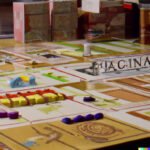Introduction
When two board games are merged together, the result is often a unique and engaging gaming experience that combines elements from both. By merging two classic, beloved games into one, you can create something entirely new, something with exciting possibilities and endless potential. Whether your goals are simply to try something new or to create a unique game night experience for a group of friends or family, merging two boards games can be an incredibly rewarding process – and one that may even be just the beginning of your journey!
The motivations for merging two board games are vast. On the one hand you may want to incorporate features from different classic board games in order to combine their best features without sacrificing any of their individual charm. For example, you might merge Monopoly boards with Clue cards in order to make a game that combines elements of both. Additionally, many people like to mix existing rulesets with totally new ones they’ve designed in order to keep the experience fresh and interesting – after all, it can become tedious if the same game is played too often! Finally, some people choose to blend aspects of multiple genres; this involves blending fantasy worlds with historical settings or mixing modern humor with traditional strategies ” truly creating something no one has seen before!
Gather Information and Materials
Players should begin researching both board games that they would like to merge. This involves looking at the rules of each game, as well as its components”cards, dice, game pieces, boards, and more. They should also research how successful board games are designed by taking note of their elements such as playability, strategic elements, artwork and player-friendly functions. After gathering information on both games players will need to gather all necessary materials”cards, boards, dice and game pieces”to construct or modify the new merged game.
Develop a New Concept – How can players create a board game that merges two preexisting ones?
Players should develop a concept for their merged board game by combining elements of each individual game in an involve manner. This includes creating unique gameplay concepts that incorporate mechanics from both games while focusing on creating unique outcomes between each match. Players can also decide on what kind of customization players have with regards to customizing their strategy or changing the look of components such as cards and boards which can all be done to personalize the experience for them. Finally, players may have to figure out a way to balance each component’s influence upon the overall gameplay outside and inside of battles/combat situations ensuring fairness is maintained during all interactions between players throughout the duration of playtime with the newly created merged board game.
Preparing the Pieces of the Puzzle
The first step in merging two board games is to take an in-depth look at the mechanics of each game. Reviewing both games and breaking them down into components such as actions, scoring systems, and equipment can provide a better understanding of their fundamental principles. Once this has been done, use the experience to come up with new ideas on integrating disparate components into a unified whole. This will involve not just designing compatible rulesets, but also considering how different elements of the gameplay can sync together, instead of clashing. From there, it’s possible to create a hybridized version from the two source materials with meaningful interactions throughout.
It may also be beneficial to reach out to players who have already experienced one or both of these games; their feedback on how different elements work (or don’t work) together could be invaluable when creating a greater synthesis out of parts that were once separate. In some cases, these conversations may even spark ideas for entirely new elements that could bring an exciting dimension to existing gameplay or introduce something uniquely suited for multiple players.
Balance Outcomes
When merging two board games, it is important to make sure that the players experience the same level of fun and enjoyment from both games. It is essential to balance out the outcomes from each game so that everyone is engaging in the same levels of play and challenge. This can be accomplished by carefully evaluating all components of each board game, such as rules, game dynamics, strategy, and other elements. For example, if one board game requires more strategic planning than the other, then consider reducing or increasing the complexity of the rules in order to create a more balanced outcome. The goal should be to provide an experience that allows players to engage with each game at an equal level that still maintains their original interest. Additionally, consider using a scoring system or tracks for each player so results are easily monitored and compared in order to ensure all individual experiences remain equally enjoyable throughout the duration of playing both games.
Find the Right Themes
The process of merging two board games can be a difficult one, and it is important to consider the themes that will be used to bring the game together. Popular themes for board games include adventure, fantasy, history, science-fiction and sports. After deciding on a theme, look at each original game’s components and mechanics to see if any of these could be used in the new game. If so, it might give the player an interesting combination of elements that they wouldn’t get in just one game but in two combined. Additionally, find out what genre of gamers each original game appeals too is important when creating the new merge because it helps create an initial vision of what kind of boardgame people will want to play. It may also help identify potential areas where a challenge or surprise elements could be included to make the game even more dynamic. Lastly, choose components such as pieces, art design and tokens that cater toward both games’ audiences for maximum appeal.
Testing and Tuning
Feedback loops give you an invaluable source of information on how to improve your combined board game and make it more enjoyable. This is where analytics come into play as they can give you metrics and insights that can help inform decisions on how to best merge the two board games to get the most out of them. As part of this testing and tuning process, you should consider a few different strategies. Look at all of the feedback you’re getting from players, analyze what works and what doesn’t in each game, find commonalities between the two games that could be merged into something better, and create rulesets that are balanced for both sides.
Once you have a prototyped version of your combined board game, it’s time for testing and tuning on a larger scale with actual players. Invite people who are familiar with both games to playtest your creation and provide feedback on how it feels, plays and looks. Use their input to adjust the rulesets accordingly until everything flows smoothly. Finally, track player behavior during each gaming session so that you get an accurate understanding of what works in terms of fun factor before releasing the final product.
Making it Permanent
Creating a permanent merge of two board games requires the formation of a committed and enthusiastic community. This can involve promotional campaigns, events, or just simply getting together with friends and family that might be interested in trying out the new hybrid game.
Once you have a strong base of devoted players, it’s important to keep content fresh and up-to-date. This can mean regularly uploading any updates or new features to the game via your own website or various gaming forums. Additionally, adding rule variations to the game at regular intervals can ensure that it’s always exciting for players to experience something new every time they play.
You could also consider running tournaments for different versions of the game, with prizes for top ranking players, as well as introducing social elements such as leaderboards which motivate participants to strive for higher scores. Finally, it’s essential to create merchandise surrounding the game; anything from branded apparel, accessories and even soundtracks could appeal to passionate gamers in your community!
Conclusion
Once you have successfully merged the two board games, players should now be able to experience a unique game that combines elements of the original two games. The possibilities are endless and will allow players to explore new strategies, discover secrets hidden within each game, and develop skills they never knew they possessed. Furthermore, depending on how complex the two board games were prior to merging, the resulting game could provide hours of entertainment.
For those looking for more guidance in playing the game or ideas on how to best use their newfound skills in various situations, there are plenty of strategy guides or books available on the internet that can provide valuable advice. Additionally, there are many online forums dedicated to the discussion of board games where players can exchange tips and tricks amongst each other about any variants or twists added via this merging process.
Overall, merging two board games offers a great opportunity for imaginative play and creative exploration. Don’t be afraid to experiment; you never know what amazing discoveries may come from it!

I love playing all kinds of games – from classics like Monopoly to modern favourites like Ticket to Ride.
I created this blog as a way to share my love of board games with others, and provide information on the latest releases and news in the industry.





